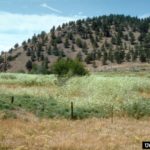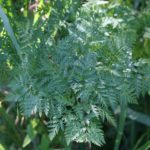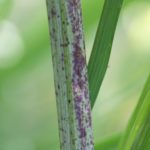Gallery:
- Poison hemlock
- Poison hemlock infestation
- Poison hemlock leaves
- Poison hemlock flower
- Poison hemlock seeds
- Poison hemlock stem
Common names:
Poison hemlock, deadly hemlock, poison parsley, carrot-fern, fool’s-parsley, spotted hemlock,
Scientific Name:
Conium maculatum
Description:
Poison hemlock is a tall biennial plant in the Apiaceae (carrot) family. It grows as a rosette the first year and then flowers the next year. It has a deep taproot and the stems are hollow, hairless, with distinctive purple spots. The leaves are alternate, fern-like and finely divided. The white flowers grow in umbrella-shaped clusters that are about 4 – 8 inches across. It spreads solely by seed and each plant can produce anywhere from 1,500 to 39,000 seeds that can live in the soil for up to six years. Seeds are dispersed by water, wind, animal fur, human clothing, boots, and machinery.
Life cycle:
Height of mature plants
3-8 feet
Flower color:
White
Bloom time:
May – September
Look-a-likes:
Poison hemlock looks like several other members of the carrot family. The closest look-alike is wild carrot, but wild carrot is smaller than poison hemlock and does not have purple spots on the stem.
Habitat:
While poison hemlock prefers moist, rich soils, it can easily adapt to other conditions and will grow in pastures, waste areas, riparian zones, ditches, and fencerows. It does not grow well in acidic soils and heavy shade.
Impacts:
Poison hemlock can quickly invade large pastures and riparian areas, reducing forage quality, poisoning livestock, and outcompeting other plants. This plant is considered one of the most poisonous plants in North America as the entire plant (especially the root and crown) is toxic to both humans and animals. Several livestock deaths are attributed each year to this species. Wear gloves when handling this plant, as it is also a skin irritant.
Noxious Weed Listing:
- WeedWise: Maintenance
- State of Oregon: Class B
- State of Washington: Class B
- Four County CWMA: Class C
- Columbia Gorge CWMA: Class B
Origin:
Asia, Europe, and North Africa
Links:
Oregon Noxious Weed Profile
Washington Noxious Weed Profile
Invasive.org profile
CABI Invasive Species Compendium






